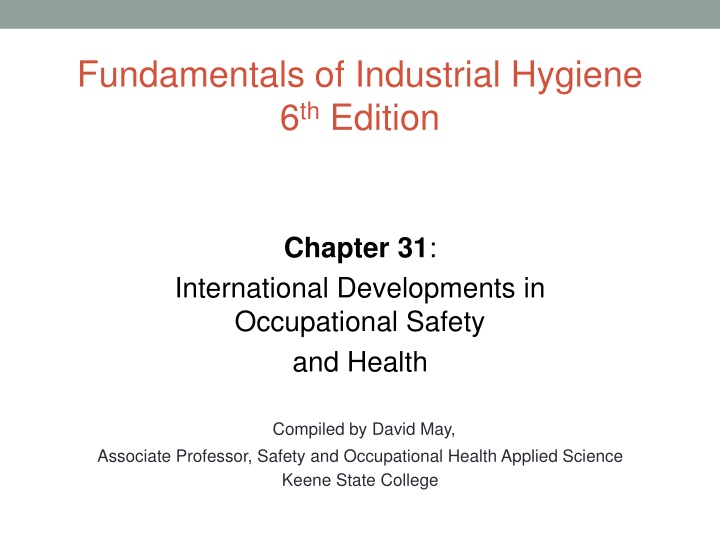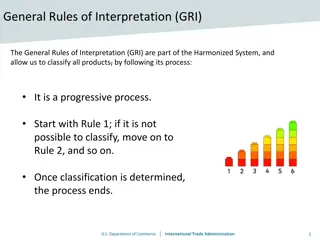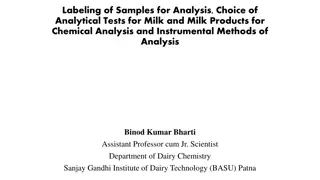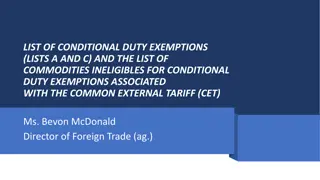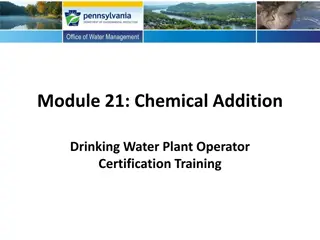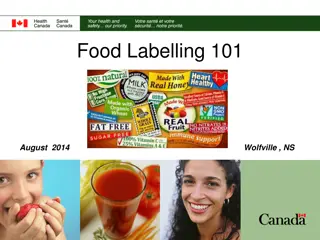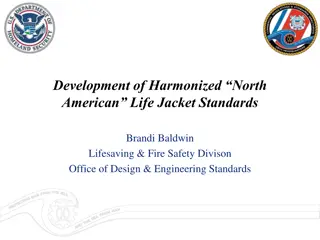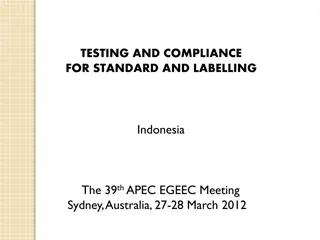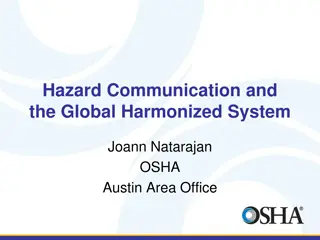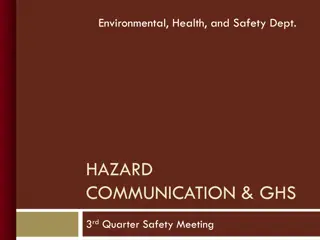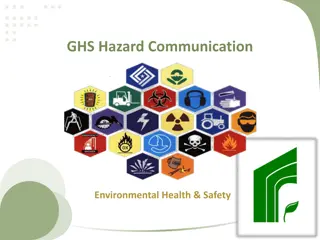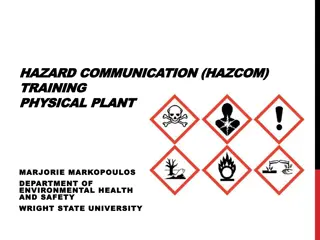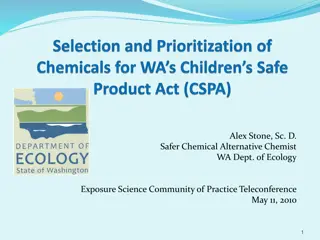Global Harmonized System of Classification and Labeling of Chemicals (GHS) Overview
The Global Harmonized System of Classification and Labeling of Chemicals (GHS) was developed to address the inconsistencies in hazard information for chemicals globally due to significant trade. The history, mandate, and provisions of GHS, along with additional domestic harmonization efforts, are discussed. GHS is based on hazard assessment, covering all chemicals in all usage situations with standardized hazard classification criteria for physical, health, and environmental hazards.
Download Presentation

Please find below an Image/Link to download the presentation.
The content on the website is provided AS IS for your information and personal use only. It may not be sold, licensed, or shared on other websites without obtaining consent from the author.If you encounter any issues during the download, it is possible that the publisher has removed the file from their server.
You are allowed to download the files provided on this website for personal or commercial use, subject to the condition that they are used lawfully. All files are the property of their respective owners.
The content on the website is provided AS IS for your information and personal use only. It may not be sold, licensed, or shared on other websites without obtaining consent from the author.
E N D
Presentation Transcript
Fundamentals of Industrial Hygiene 6thEdition Chapter 31: International Developments in Occupational Safety and Health Compiled by David May, Associate Professor, Safety and Occupational Health Applied Science Keene State College
Globally Harmonized System of Classification and Labeling of Chemicals (GHS) Needed because of significant global trade in chemicals critical hazard information missing depending on source inconsistent approaches for classifying chemicals varying definitions of important definitions (e.g., flammables, carcinogens) inconsistent recommendations for protecting workers
History of GHS Mandate: United Nations Conference on Environment and Development; 1992 (Earth Summit) Available for implementation 2003 ( Purple Book ) Published by the United Nations UN Subcommittee on the Globally Harmonized System of Classification and Labeling of Chemicals maintains and oversees implantation around the world USDOL/OSHA GHS Final rule promulgated 2012 Phased-in compliance dates (through 2015)
Additional Domestic Harmonization US DOT transportation of dangerous goods EPA labeling of pesticides CPSC (chemicals in consumer products)
GHS Design/Basis Based on hazard assessment i.e., the intrinsic hazardous properties of the chemical Not risk-based acceptable risk must be determined by user counties and application situations
GHS Provisions Scope: covers all chemicals in all usage situations i.e., no exemption of certain classes of chemicals (e.g. pesticides) Products may be covered in some parts of the life cycle of the but not others (e.g. pharmaceuticals) Chemical manufacturer or importer responsible for evaluating hazards
Hazard Classification Classification criteria Physical hazards Health and environmental hazards
Physical Hazards Explosives Flammability gases, aerosols, liquids, solids Oxidizers liquid, solid, gases Gases under pressure Aerosols
Physical Hazards (cont.) Self-Reactive Substances and Mixtures Pyrophoric liquids, solids Self-Heating substances and mixtures Organic peroxides Corrosive to metals Water-activated flammable gases
Health Hazards Acute Toxicity Skin Corrosion/Irritation Serious Eye Damage/Eye Irritation Respiratory or Skin Sensitization
Health Hazards (cont.) Germ cell mutagenicity Carcinogenicity Reproductive toxicity Target organ systemic toxicity single and repeated dose Aspiration hazards
Environmental Hazards Hazardous to the Aquatic Environment Hazardous to the Ozone Layer
Forms of Hazard Communication Labels Safety Data Sheets (SDS) Training
Key Label Elements Hazard pictograms Signal words Hazard statements Precautionary information Product identifier Supplier identifier Chemical identity
Signal Words Danger or Warning Used to highlight the hazard and discriminate between levels of hazard
Hazard Statements A single harmonized hazard statement for each level of hazard within each hazard class Example: Flammable liquids Category 1: Extremely flammable liquid and vapour Category 2: Highly flammable liquid and vapour Category 3: Flammable liquid and vapour Category 4: Combustible liquid
Precautionary Statements GHS label should include appropriate precautionary information (examples of precautionary statements are found in the GHS document ). Currently the statements are flexible, but the intent is to harmonize precautionary statements in the future.
Role of the SDS in the GHS The SDS should provide comprehensive information about a chemical substance or mixture. Primary use: the workplace Employers and workers use the SDS as a source of information about hazards and to obtain advice on safety precautions.
SDSFormat: 16 headings Identification Hazard(s) identification Composition/information on ingredients First-aid measures Fire-fighting measures Accidental release measures Handling and storage Exposure control/personal protection 1. 2. 3. 4. 5. 6. 7. 8.
SDS Format: 16 headings (cont.) Physical and chemical properties 9. 10. Stability and reactivity 11. Toxicological information 12. Ecological information 13. Disposal considerations 14. Transport information 15. Regulatory information 16. Other information
Training Training is necessary to implement GHS system, but provisions are not harmonized. In the United States see: OSHA s Hazard Communication standard for training requirements
Control Banding Attempts to address the risk assessment of 100,000s of chemicals without occupational exposure limits (OELs) Qualitative approach to assess chemical risk and select appropriate control measures Attributed to the pharmaceutical industry and United Kingdom s COSHH Essentials
Control Banding (cont.) Risk based on chemical hazards and potential for exposure Utilized risk phrases (R-phases); now harmonized with GHS (Hazard Statements or H-Statements)
Control Banding (cont.) Selection of Four Control Strategies Source: http://www.coshh-essentials.org.uk/
REACH Registration, Evaluation, Authorization, and Restriction of Chemicals Enacted as E.U. regulations concerning importing and selling of chemical products in Europe Covers complete life-cycle of product
REACH Requirements Registration of substances Detailed evaluation of hazards posed by substance Substances can be restricted or prohibited if risk is unacceptable Obligates downstream users to implement conditions of use from suppliers
REACH Requirements (cont.) Technical dossier and/or chemical safety assessment depending on quantity of substance manufactured or imported Risk characterization: Derived No Effect Levels (DNELs) determined for substances used to Predicted No Effect Concentration (PNEC) Exposure Assessment: Exposure scenarios developed for specific set of operational conditions for downstream users
Occupational Health and Safety Management Systems (Examples) Voluntary Protection Program (VPP) ANSI Z-10 (Occupational Health and Safety Management Systems) ISO 14000 (environmental management system) BSI Occupational Health and Safety Assessment Series 18000
